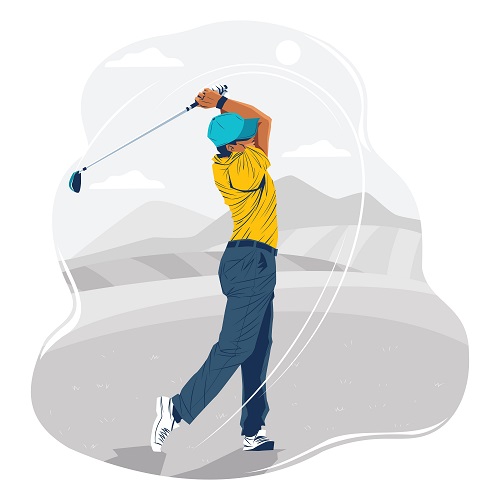How to Improve Golf Swing Effectively
The Best Golf Swing Tips
Golf is a unique game.
Dating back to the origins of the game (rumored to have first been played in the year 1457), players have dedicated themselves to improving their golf swing.
So much so that during the reign of King James II of Scotland, playing and practicing golf was outlawed.


In a hurry? No worries. You can have a shorter version that’s packed with everything you need to know about the driving range. Just tell us where you’d like to receive it and we’ll send it straight to your inbox.
What You Will Learn In This Post
It seems that, even then, players were so obsessed with improving their game that they were ignoring their mandated archery practice for the sake of “banging balls” at the range…or the pasture if the range was busy.
Then, why is it so hard to master the golf swing?
Good question.
I would like to think that I could come up with an equally good answer. The truth of the matter is that there are many answers to this question.
For me, the journey to mastering the golf swing started 45 years ago. I am nothing if not patient.
Always remember this quote by one of the best renowned sports psychologists of this age…
Golf is not a game of perfect.
Bob Rotella
Famous Sport Psych
Especially in the beginning, it is important to keep your goals realistic. I have seen many people lose hope and give up simply because they have been unrealistic in their development curve.
In this article, I will answer many questions that will undoubtedly arise as we search for the “swing of perfection”.
The first thing to come to grips with in your quest for a great golf swing is that you have to be as realistic as possible. You need to understand the fundamentals.
It also helps to stay comfortable on the golf course.
CHAPTER 1
Fundamentals of the Golf Swing
Fundamental #1: Position yourself in line with the flag
This is best done by standing behind the golf ball and looking down the fairway at your target.
Remember that the flag is not necessarily your target.
A trick to this is to pick out an intermediate target no more than 10 feet in front of your ball.
It can be a leaf, twig, pebble, or something as simple as a discolored piece of grass.
This will allow you to have a focal point that is manageable to your thought process.
Fundamental #2: Grip your top hand properly
The shaft lies in your fingers, not your palm.
Your pinky finger wraps around the club just down from the butt end.
At this point, your thumb should be pointed straight down the shaft. If you have a neutral grip, two knuckles will be showing. The angle of your wrist should be correct. And slightly bowed.
Fundamental #3: Complete your grip by placing your right hand on the club
Grip the club with your bottom hand in a comfortable manner. At the same time, position the back of your bottom hand according to whatever grip you have chosen.
Start by shaking hands with the golf club. The exact positioning of your right hand will depend on which grip you choose to use.
- If you are using a Vardon/Overlap grip, the pinky finger of your bottom hand will fold over the index finger of your top hand and sit naturally between the index and middle finger of your top hand.
- If you choose an interlocking grip, the pinky finger of your bottom hand will interlock with the index finger of your top hand.
- If you choose to use a 10-finger/Baseball grip, your pinky finger on your bottom hand will simply butt up against the index finger of your top hand.
Which golf grip is right for you?
If you want to learn more, we’ve released an in-depth guide specifically on how to grip & hold the golf club.
In all of these grips, assuming you want a neutral grip, the thumb on your bottom hand should now be pointing at the appropriate shoulder.
Fundamental #4: Adopt a strong athletic stance while addressing the ball
Place your feet shoulder width apart. Your body must be parallel to the target.
Check your feet, knees, hips, and shoulders to confirm your stance is square to the target.
Place your back foot perpendicular to your intended ball flight. Your front foot should be parallel to your target line but flared open. This is done to aid in clearing your hips.
The older you get, the more you will need to flare this foot.
Bend your upper torso while at the same time flexing (not bending) your knees slightly. This is what I refer to as a “strong athletic position”.
This position is used in almost all sports and is absolutely essential in developing a proper golf swing. As you can see in the video above, the spine angle that our golfer has is approximately 40 degrees off of his vertical axis.
A spine angle of more than 40 degrees will find you bobbing down on the backswing and then back up as you initiate your downswing.
If your spine angle is less than 40 degrees at address, you will never realize 100% power throughout your swing.
Your arms should hang comfortably. At address, there should be a hand width between the butt end of the club and your body.
Make sure your body weight is on the balls of your feet. Never should your weight be on your heels.
Your “strong athletic position” should make this easy to accomplish.
Keep both arms straight but relaxed at address, with your front shoulder a bit higher than the back shoulder.
This should occur naturally, as your bottom hand is lower on the grip, thus keeping your back shoulder lower than the front.
Fundamental #5: Perform your swing
Time to check that your weight is not only on the balls of your feet but also evenly distributed.
As you develop your swing, you will undoubtedly experiment with weight distribution at the start of your swing, but I would suggest that you start with a neutral position.
It will help you understand the dynamics of your golf swing.
Time to waggle. I know that you have all seen it done. I also know that, deep down, you have wanted to do it. You may not understand why…you just want to do it.
What is the purpose of the Waggle?
For one thing, it helps relax the large muscles, which at this point, are raring to get going. In addition, it helps develop a pre-shot routine, which is also something that will come with time and experience.
As you start your backswing, try to pay attention to rotation.
Even though we are talking about a near simultaneous occurrence, the hands being taken away on a linear plane are nowhere near as important as the rotation being put in place by turning the shoulders and then the hips.
Another common mistake made by beginners is in their grip pressure. The club must be gripped lightly. Many golfers look like they are trying to wring the rubber out of the grip…
…WRONG!!
In addition, it is important to maintain this grip pressure throughout the swing, all the way to follow through.
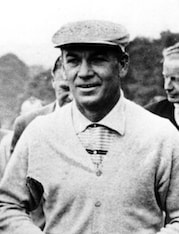
Note at this point, during rotation, how the back is maintaining the spine angle and is turned away from the target at the top of the backswing.
If you were to look closely at golf professionals when they get to this point of their swing, you would see that their front shoulder would be firmly placed under their chin.
Fast forward to their follow through and you would see their back shoulder in the same position under their chin.
Ben Hogan used to actually wear the shoulders of his golf shirts out well before any other part of his shirt.
Please take note that the initial movement of the takeaway is not a rotational one. The rotation I talk about here occurs naturally slightly after the initial linear takeaway of the hands.
When the rotation starts, the hands, arms, shoulders and hips rotate almost in unison to create a circular rotation on a tilted axis.
The first thing that has to happen is that your weight must gradually shift to your back foot so that there is little to no weight at all on your front foot.
As your shoulders get fully turned, your back should be facing away from the target.
Sometimes, physical limitations keep you from making such a complete turn. If this is the case, try some isometric stretching exercises to train yourself to make a more complete turn.
If this is simply not possible, do the best you can and live with a shorter, more compact swing.
Now the downswing starts. The first move has to be a commitment to transferring the weight from your back foot to your front.
At the same time that the weight is being transferred, there is a natural occurrence of the built up rotation being reversed in a spring-like motion.
When you look at golfers who are slight in proportion, this is the main reason why they can drive the golf ball so far. This is your point of no return.
Your hands, shoulders, hips, and knees have no option but to get on board.
At impact, your hips and shoulders should have returned to their address position of being parallel with your target line.
Your right foot should remain planted on the ground until after impact and then rise gradually to allow you to rotate to follow through.

It is very important to be diligent here and allow your body to release and become square to the target in your follow through position.
Your body should remain relaxed all the way through the golf swing. I know it seems impossible, but with practice, you will be able to succeed in this.
Sound a little intimidating? Wait…here’s the hard part.
This complete motion should be unbroken right from the takeaway all the way through to the follow through.
Here are a few things to remember about golf swing tips:
- Hips first, then shoulders, then hands
- More distance comes from more ball speed…more ball speed comes from more club head speed…more club head speed comes from faster rotation
- Perfection is unattainable…but that doesn’t mean we shouldn’t strive for it
CHAPTER 2
Tips and Exercises to Improve Golf Swing
Here we’ll go into a few exercises that will cause you to improve your golf swing.
Takeaway
 Jack Nicklaus – Legendary Golfer
Jack Nicklaus – Legendary Golfer
The most important 18 inches in golf is the takeaway.
The term low and slow has been used by instructors throughout the ages.
As a result, many drills have been developed to help players in this area. Most of them revolve around adding some weight to the club head in an attempt to keep the player’s takeaway under control.
There are golf swing aids that you can attach to your club head that will accomplish the desired effect. These are drills you can easily practice at the driving range and experience great results.
I met a teaching professional years ago by the name of Wally Armstrong, who suggested to me that using a floor mop might be a better simulation of exactly how slow the takeaway should feel.
Try it.
Taking the mop in your hands as you would a golf club, it is virtually impossible to take it away too fast.

The combination of weight and surface size dictates a “low and slow” takeaway.
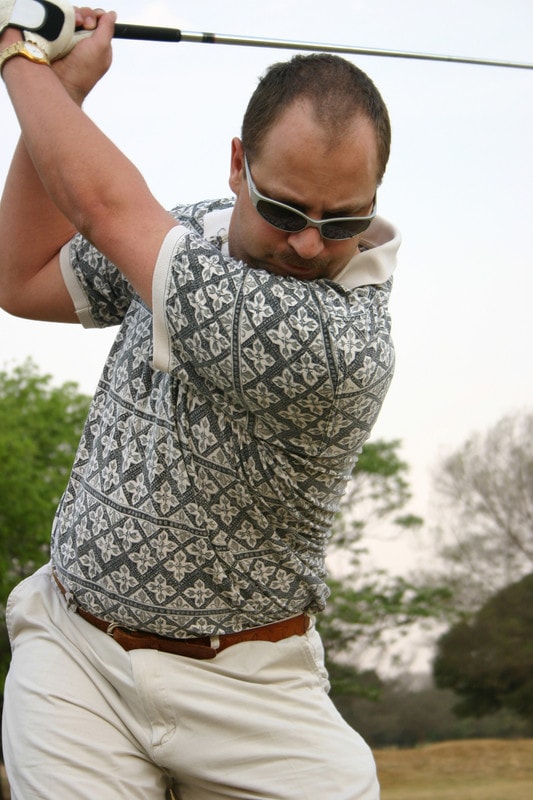
Here is another tip that might help in developing a smooth takeaway.
More often than not, a poor takeaway results in picking the club up too fast instead of the club gliding back into position.
Concentrate on allowing your front shoulder and arm to push the club back as it starts on it’s takeaway journey.
This should keep your back arm and shoulder from taking over and trying to speed up the whole thing.
Don’t condemn your golf swing before it has a chance to get going. Master your takeaway you will be well on your way to having a repeatable golf swing that you can be proud of.
Weight Transfer
The next step for you to take is to ensure that your weight transfer is what it should be.
If you don’t, you will fall victim to the dreaded reverse pivot.
The best way to describe a reverse pivot is this. A proper weight transfer has your weight moving back during the backswing and forward through the downswing. A reverse pivot results in the exact opposite occurring.
Here is a drill to help combat that.
Drill: Happy Gilmore
If I find myself falling victim to a reverse pivot (and I have from time to time over the last 40 years), I do the “Happy Gilmore”.
For those of you who have seen the movie, you will be familiar with Happy’s run up to the ball style. You don’t have to go to that extreme, but the premise is the same.

Simply get in your normal stance and address position.
Take the club back as you normally would, but when you get to the top of your backswing, take your front foot and bring it back so that your feet are together.
Remember that the swing must be continuous. Without losing momentum, start your downswing and step into the swing with your front foot and complete your swing.
Don’t try to square up your front foot. The momentum could result in injury.
Flare your front foot and allow your hips to follow as you transfer your weight to a 100% forward position.
This drill will guarantee two things. Number one. You will most definitely get your weight fully onto your back foot. Number two. There is no way that you cannot then transfer that weight to your front foot.
Collect everything together at the top
There have been many professional golfers who have utilized this swing thought. I have even heard of the “pause” as a golf swing enabler.
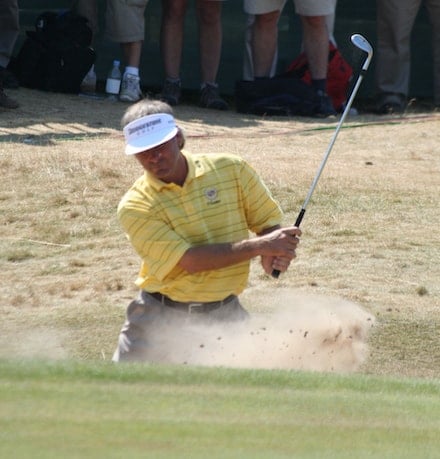
My favorite example of this is Fred Couples. He had that type of pause throughout his bag.
Whether it be his full out driver or his wedge play around the green, he seemed to always have that slight pause that allowed him to channel his energy and focus into a well thought out and executed swing.
A good swing thought for beginners and players who are determined to master their golf swing would be to develop good timing. I was taught this many years ago.
Another drill is nothing more than a forced pause. The drill is simple but effective.
As you get to the top of your backswing, make a conscious decision to pause for no more than the count of one.
When you do start your downswing, be a little more aggressive than you would normally be. The whole idea of pausing at the top is to maximize your power while maintaining precision.
Downswing
The best thing I ever heard about the downswing is that it starts from the bottom up.
A beginner’s golf swing tends to be more steep than it should be. I believe that a downswing that starts from the bottom up helps to lessen the steepness and develop an inside-out swing that is more desirable.
Although there are a myriad of things to do in order to perfect your downswing, here are a few swing thoughts and ways to develop a solid downswing.
Stay away from the dreaded “Chicken Wing.”
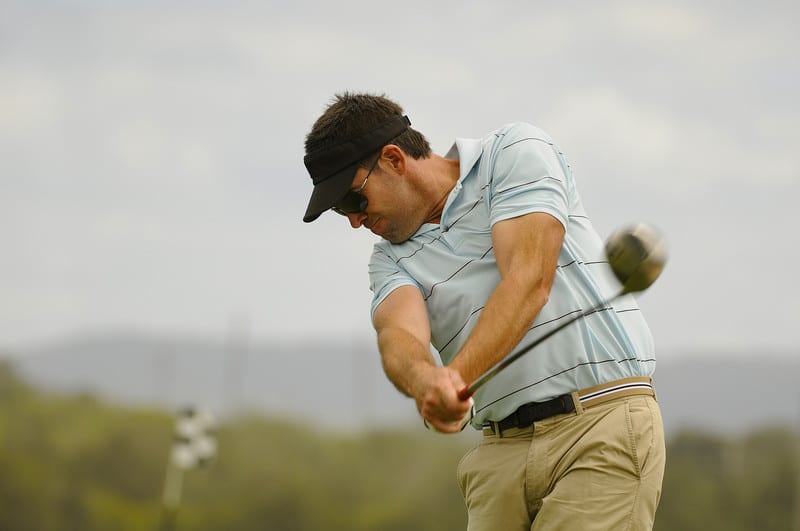
“Chicken Wing” is a slang term for your lead arm flailing away like a chicken trying to fly.
From a physics perspective, the “Chicken Wing” simply saps all of the energy built up by a proper backswing in that the lead arm is bent and does not allow you to release the energy needed to swing the golf club with any power.
The following drill will help you do two things:
- It will help you identify and feel the problem when it occurs
- Most importantly, if done properly, it will help you to keep your lead arm from flailing about
Place your headcover (or a rolled up golf towel) under your lead armpit. Hold it there throughout your swing.
When you perform your swing properly, it should remain under your armpit until after contact.
If it falls out prematurely, this will confirm that your lead arm is out of control and that you indeed suffer from “Chicken Wing.”
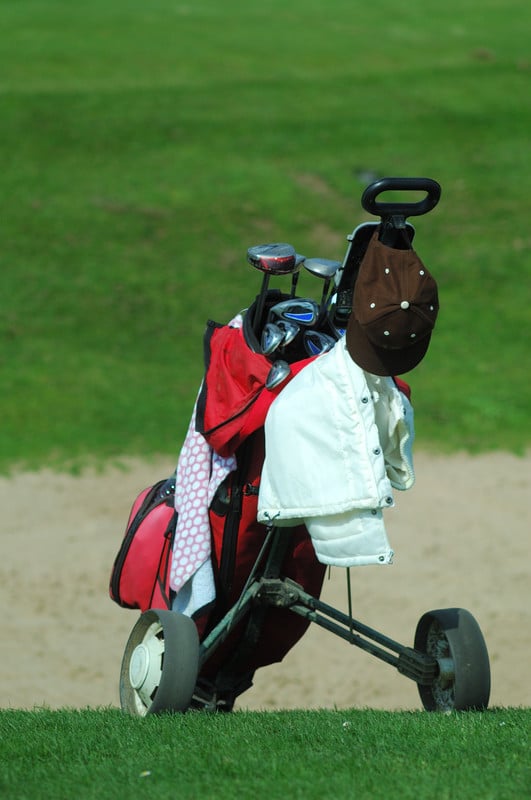
Follow Through
Few golfers realize how important it is to have a good follow through.
One of the first things I talk about when dealing with beginner golfers is how the position of your back arm and shoulder at the top of your backswing should mirror the position of your lead arm and shoulder at the finish position.
I use a drill that simply adds a little weight to my swing. That encourages me to “let go and let flow,” as I like to call it.
Take your 6 iron and 7 iron and swing them together. Start with half swings and gradually work up to full swings. The added weight will not allow you to shorten your follow through without hurting your wrists.
This drill should be done either as part of your practice routine or your first tee warm up procedure.
CHAPTER 3
Common Mistakes That You Should Avoid
After discussing many exercises that will improve your golf swing, we’ll cover the most common mistakes made when doing a golf swing.
1. Casting the club, or coming over the top

This move is not only one that affects beginners but seems to creep into many golfers’ swing over time.

The result of this is a golf shot that usually goes weakly to the right (for a right-handed golfer) due to spin imparted on the ball as a result of an improper swing path.
I constantly have to work on this issue, and I have played golf for more than 40 years.
It reduces the distance you are able to hit your driver and hinders solid contact with the rest of your clubs.
Casting the club is a mistake that must be fixed in order to develop a swing path that allows you to establish and maintain a repeatable golf swing.
A simple way to keep from casting the golf club is to take your back foot and move it inside, closing your stance in the way a baseball player might do in the batter’s box.
Move your foot into a position that is somewhat uncomfortable.
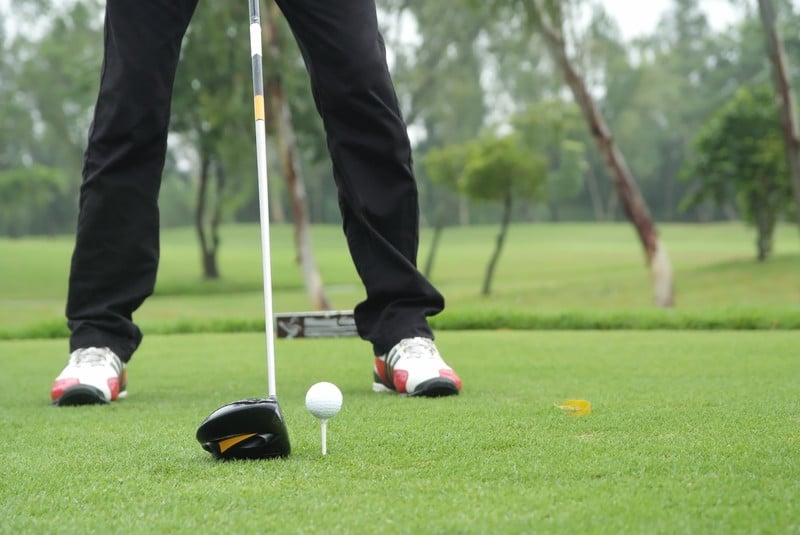
Swinging the golf club while in this position should make it difficult, if not impossible, to come over the top.
Practice in this way until the mistake is cured, and then gradually move your foot back into it’s original position. The whole idea is to train yourself so that the swing is natural.
2. Improper grip pressure

This is another area that golfers have to pay particular attention to. It is human nature to tense up when under pressure.
And, believe me, golf puts more pressure on the player than any other sport.
Whether it be on the tee with trouble abound, on the fairway having to avoid hazards near the green or even in a green side situation trying to get up and down to save par, your heart rate will quicken when presented with these things.
The trick is to try to slow down and control that feeling that you have to overpower the game.
A trick I learned is to suck on hard candies when practicing. When we grip the golf club too hard, it is usually accompanied by a clenching of the teeth.
Sucking on hard candies makes it hard to bite down and clench your teeth. In addition, I sometimes eat potato chips when chipping and putting.
Put a chip between your teeth and try not to break it as you take your stroke. It’s harder than it sounds. The resulting snack is also a nice reward for yourself.
3. Underclubbing

I see many amateurs fall into this mistake. You assess your yardage and assume that you can get there with whatever golf club you choose.
The problem is if you choose a golf club that you need to hit 100% to achieve that yardage, you don’t take into account that this is not the range and that your lie might not be perfect and the strike might not be perfect enough to get to your desired yardage.
The simple fix is to throttle back on your irons, especially your scoring clubs.
If you practice at, say 85% then you will find yourself able to assess and control your approach shots more accurately.
In addition, you will have something left in the tank if you do want to give it a little more oomph because of circumstances that might demand it.
As an additional precautionary measure, I recommend you make sure this doesn’t cause you to stop to top the ball – if this is the case, solutions exist to fix this issue quickly.
4. Not opening up to the golf course

What I mean here is that most amateurs tend to get tunnel vision when they stand on the tee box.
They identify where they want the golf ball to end up, but ignore how they intend to get it there. In truth, most players, professionals included, do not play a straight ball.
What I mean is that they have a ball flight that is somewhat consistent, either left to right or right to left. Identify that flight and then play for it.
The key is to make that flight that you have as consistent as possible.
The fix here is not so much a drill, but more of a course management issue.
For example, if there is trouble down the left side of a fairway, and you have a somewhat consistent left to right ball flight, then the smartest play would be to tee up on the right side of the tee box, aim at the right edge of the trouble and let your tendencies take over.
But be careful. In the same situation, if your ball flight has a tendency to be right to left, then you need to tee up on the left side of the tee box (the same side as the trouble).
Aim as far right as you can (protecting yourself from the dreaded straight shot) and then swing away and rely on statistics.
There will always be times when the shape of the hole and the troubles it presents will make you uncomfortable. Do your best and be in control of your golf ball.
You might want to check the Best Golf Courses in Houston.
CONCLUSION
CONCLUSION
Now It’s Your Turn
Make learning the game less difficult and not more. Whatever it takes to lift the “fun factor,” do it.
Some like to know more about the physics of the golf swing.
If that is you, embrace it and dive in headfirst to the endless resources out there that do exactly that.
Others might be more hands on and commit to learning strictly through repetition.
I know some beginners that will insist on learning from watching. This also works.
I hope that I have clearly communicated the importance of striving towards mastering the golf swing.
My golf journey has been one of the most enjoyable things I have ever done.
I just know that it would have been somewhat less if I had not had a commitment to the thing that contributed to the journey the most…my golf swing.
Take possession of it, embrace it, commit to it and the two of you will become inseparable.
On top of what we’ve covered today, I recommend you check out our article on how to draw the golf ball which comes as a nice addition to mastering the golf swing.
